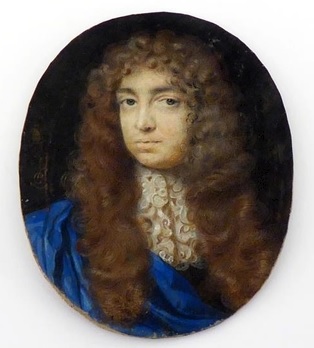A reader has kindly alerted me to a late 17th century miniature that is coming up for auction.
Painted by Peter Cross (1645-1724), it dates from around 1685, and apart from a few minor wear issues, appears to be in very good condition for its age.

He looks like a typical late Restoration gentleman, but on the reverse it is written that he is not just an ordinary man, but royalty, in the form of “James, Duke of York”, later King James II. Who wrote the label is unknown, but doubts exist about the claim thanks to, of all things, the size of his nose.
King James II was known to have a rather large and unflattering nose, while this man’s is quite ordinary and inoffensive.
Here’s James’s…

I would have to agree that the miniature is unlikely to be James, and the label most likely added by some unknown scribe in hope more than certainty, but it is a lovely picture all the same! I hope it finds a good home when it sells in a few days.

dépaysement
/ March 20, 2017I would say no way is that James, unless Cross turned into a very poor portraitist on this occasion. James has the long Stuart-Bourbon face, large mouth and full lower lip, and heavy-lidded eyes. The fellow in Cross’s miniature has none of those. His face is round and nose small, and his eyes look Lelyesque rather than anything else imo. I bet someone looked at his red wig and decided he was James on that basis (and to bump up the value, maybe?) back in the day.
LikeLike
rfjblog
/ March 20, 2017Agreed. Our man is too ‘pretty’ to be a Stuart!
LikeLike
dépaysement
/ March 20, 2017The Stuarts aren’t pretty, but they’re sure attractive! (Well, in those two generations at least.)
LikeLike
Susanne
/ March 21, 2017He’s also too plump and not particular intelligent looking. And the chin is wrong. James II he is not but who then is he?
LikeLike
dépaysement
/ March 21, 2017Yes, the last time James was that round-faced, he was being painted by Van Dyck.
LikeLike
rfjblog
/ March 21, 2017He’s definitely someone of importance, or at least money. A high ranking courtier, perhaps, or the son of someone close to the Court?
LikeLike
dépaysement
/ March 21, 2017Yes indeed.
LikeLike